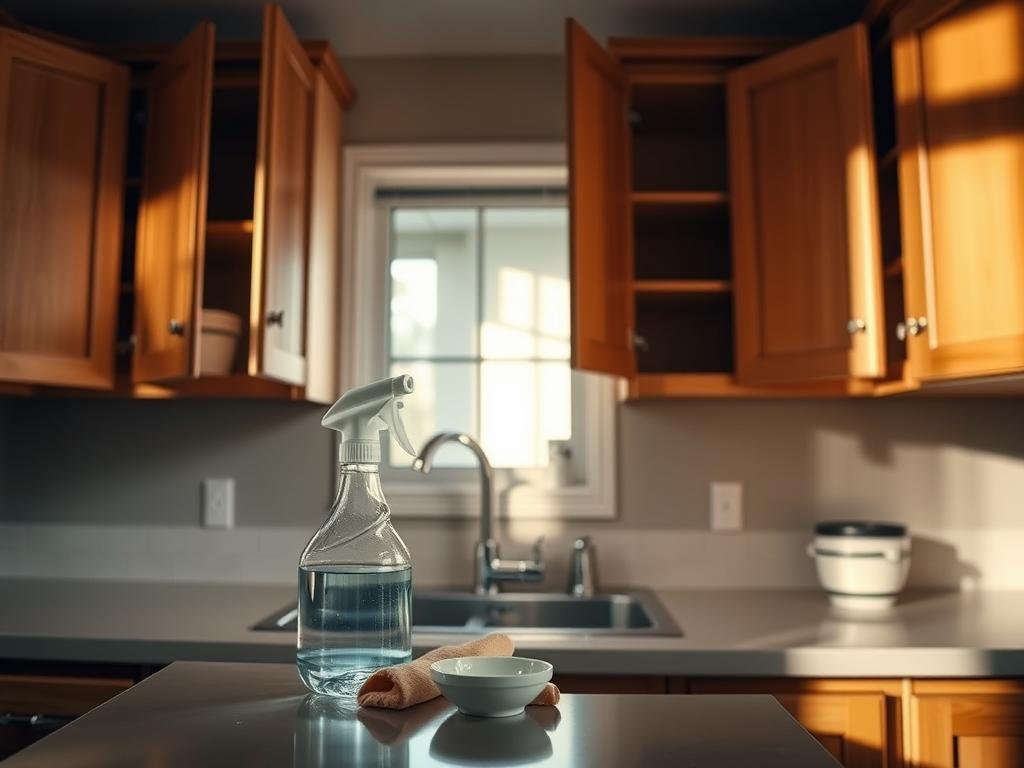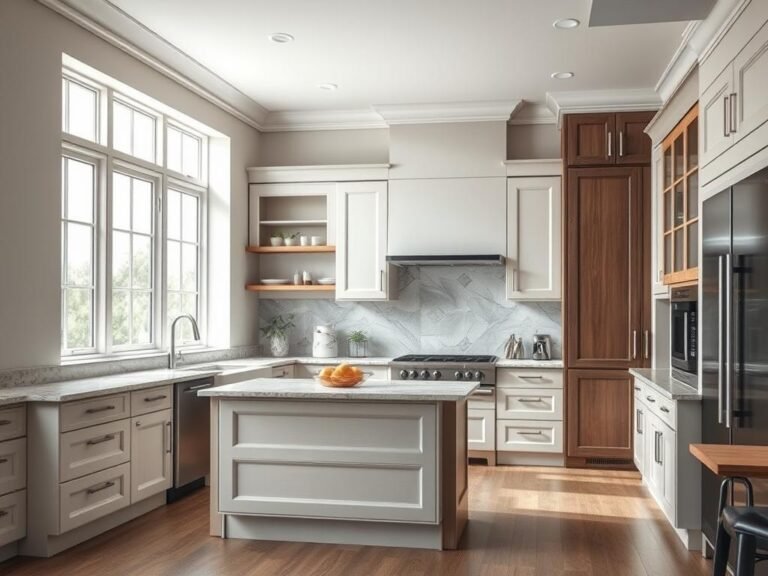Ever wondered why your kitchen cabinets lose their shine over time? The answer lies in the buildup of grease, dust, and grime that accumulates with daily use. Keeping your cabinets spotless not only enhances the look of your kitchen but also extends their lifespan. The good news? You don’t need expensive products or harsh chemicals to get the job done.
Regular maintenance is key. A simple mix of mild dish soap and warm water can work wonders for most surfaces. For tougher stains, a baking soda paste or a vinegar solution can be effective without damaging the finish. Always test any product on a small, hidden area first to ensure it’s safe for your cabinet material, whether it’s wood, laminate, or painted1.
Deep cleaning should be done once or twice a year. This involves emptying the cabinets and wiping down both the inside and outside surfaces. Start from the top and work your way down to avoid recontaminating cleaned areas. Using a microfiber cloth ensures a streak-free finish, while a soft toothbrush can tackle hard-to-reach spots like hardware and corners2.
By following these steps, you’ll maintain a fresh and inviting kitchen environment. Plus, you’ll save money by using products you likely already have at home. Ready to transform your cabinets? Let’s dive in!
Key Takeaways
- Regular cleaning prevents grease and dust buildup, keeping cabinets looking new.
- Mild dish soap and warm water are effective for most cabinet surfaces.
- Deep cleaning once or twice a year ensures thorough maintenance.
- Test cleaning solutions on a small area to avoid damage.
- Use microfiber cloths and soft toothbrushes for detailed cleaning.
- Start cleaning from the top and work your way down for efficiency.
- Common household products can save money and deliver great results.
Understanding the Need for Regular Cabinet Cleaning
Keeping your cabinets in top shape is more than just a chore—it’s a necessity. Over time, spills, grease, and dust can accumulate, leading to a dull appearance and potential damage. Regular maintenance ensures they stay functional and beautiful for years to come.
Benefits of a Clean Kitchen Environment
A spotless kitchen enhances the overall design of your home. It also improves air quality by reducing bacteria and viruses lurking on surfaces. Experts recommend a deep clean once or twice a year to maintain hygiene and prevent long-term damage3.
Using a microfiber cloth dampened with warm water is effective for most cabinet types. For tougher spills, a solution of mild dish soap and water works wonders without harming the finish3.
Risks of Neglecting Your Cabinets
Ignoring routine care can lead to stubborn stains and discoloration. Prolonged exposure to spills and food particles may damage delicate finishes, especially on wood surfaces3.
Harsh cleaners like bleach or ammonia can cause irreversible harm. Instead, opt for pH-neutral solutions to protect your cabinets4.
Small daily efforts, such as wiping down surfaces, reduce the need for intensive deep-cleaning sessions. This saves time and keeps your kitchen looking its best5.
Everyday Cleaning Techniques for Kitchen Cabinets
Daily spills and dust can dull your cabinet’s appearance, but quick fixes are easy. With the right approach, you can maintain their shine without spending hours scrubbing. Here’s how to keep your surfaces spotless and finishes protected.

Quick Clean-Up for Daily Spills
For everyday messes, a damp microfiber cloth works wonders. Mix one part mild dish soap with two parts warm water for a gentle yet effective solution6. This ratio ensures grease and grime are removed without harming the finish.
Start by wiping from the top of the cabinet door and work your way down. This prevents drips from recontaminating cleaned areas. For stubborn spots, a soft toothbrush can reach crevices around knobs and handles6.
Safe Practices to Protect Finishes
Avoid excess moisture, as it can damage painted or wood surfaces. Always wring out your cloth thoroughly before wiping6. For hardware, use a dry microfiber cloth to prevent rusting7.
After cleaning, wipe down the area with a clean cloth dampened with warm water. This removes any residue and leaves your cabinet doors looking polished6.
By following these simple steps, you’ll keep your surfaces gleaming and extend the life of your finishes. Small daily efforts make a big difference over time.
What to Use to Clean Kitchen Cabinets: Expert Product Recommendations
Effective cleaning doesn’t require expensive products or harsh chemicals. With the right tools and solutions, you can restore your cabinet’s shine and keep them looking fresh. Here’s a guide to DIY mixtures and top product picks that deliver results.

DIY Cleaning Solutions with Mild Dish Soap and Vinegar
For a simple yet powerful solution, mix one part mild dish soap with two parts warm water. This mixture effectively removes grease and grime without damaging the finish8. Add a splash of white vinegar for extra degreasing power. Vinegar’s acidity cuts through stubborn buildup, making it ideal for tough stains9.
Apply the solution with a microfiber cloth for a streak-free shine. Always test on a small, hidden area first to ensure compatibility with your cabinet material10.
Top Product Picks for Tackling Grease and Grime
If you prefer ready-made solutions, consider these expert-recommended products:
- Scotch-Brite Sponges: Perfect for scrubbing without scratching surfaces.
- OXO Deep Clean Brushes: Designed to reach tight corners and hardware.
- Method Daily Granite Cleaner: Safe for wood and laminate finishes.
These items are available on popular platforms like Amazon and Walmart. Switching to eco-friendly options not only protects your cabinets but also benefits the environment9.
By using these tips and products, you’ll maintain a spotless and inviting space. Small efforts today can prevent costly repairs tomorrow.
Deep Cleaning and Maintenance Strategies
Maintaining the sparkle of your storage spaces requires more than just surface-level attention. Over time, grease and dust can accumulate in hidden corners, making a thorough cleaning essential. A deep clean not only restores the shine but also ensures longevity for your surfaces.

Step-by-Step Deep Cleaning Process
Start by emptying your cabinets completely. This allows you to access every nook and cranny. Use a microfiber cloth dampened with warm water to wipe down the interiors. For stubborn stains, a baking soda paste can be effective without damaging the finish11.
Next, focus on the exteriors. Begin at the top and work your way down to avoid recontaminating cleaned areas. A soft toothbrush is perfect for reaching hardware and tight corners. Always dry surfaces thoroughly to prevent water damage12.
Tips for Cleaning Hard-to-Reach Areas
Hardware and crevices often collect dust and grime. A toothbrush or a delicate scrub pad can help tackle these spots. For greasy buildup, a 50-50 solution of water and vinegar works wonders13.
After cleaning, ensure all areas are dry. This prevents moisture from seeping into wood or painted surfaces, which can cause long-term damage. Regular deep cleaning, done three to four times a year, keeps your cabinets in top condition11.
By following these steps, you’ll maintain a fresh and inviting space. Plus, you’ll extend the life of your surfaces with minimal effort.
Special Considerations for Painted and Wood Cabinets
Painted and wood cabinets require special care to maintain their beauty and durability. Unlike standard finishes, these materials have unique needs that demand attention to detail. By understanding their specific requirements, you can keep them looking pristine for years.

How to Safely Maintain Painted Surfaces
Painted surfaces are delicate and can easily chip or lose their sheen if not handled properly. Non-abrasive methods are essential to preserve their integrity. Avoid harsh cleaners like bleach or ammonia, as they can peel or damage the finish14.
For everyday care, use a soft cloth dampened with mild soap and water. This gentle approach removes grease without harming the paint14. For stubborn stains, a baking soda and vinegar solution works effectively15.
Always dry surfaces thoroughly after cleaning. Moisture left behind can seep under the paint, causing long-term damage14. Regular inspections help catch early signs of wear, ensuring your cabinets stay in top shape.
Guarding Your Wood Cabinets from Damage
Wood cabinets are prone to warping and discoloration if exposed to excessive moisture or improper cleaning. Use a wood-specific cleaner to nourish and protect the material15. Avoid products with waxes or oils, as they can damage painted finishes.
Maintain a stable environment by controlling temperature and humidity. Sudden changes can cause wood to expand or contract, leading to cracks15. Wipe spills immediately to prevent stains from setting in.
For a natural shine, polish with a dry cloth. This simple step enhances the wood’s natural beauty while protecting it from daily wear and tear.
Conclusion
Maintaining the beauty of your storage spaces is easier than you think. A gentle approach with mild cleaner and a soft cloth keeps surfaces spotless without damage. Regular care prevents grease and grime buildup, ensuring your cabinet stays functional and attractive16.
For stubborn stains, a simple solution of vinegar and water works wonders. Experts recommend testing products on a small area first to avoid harm17. By scheduling routine maintenance, you’ll save time and effort in the long run.
Taking pride in your kitchen means paying attention to every detail. A spotless space not only looks great but also promotes hygiene. Start today and enjoy the lasting benefits of a well-maintained home.




